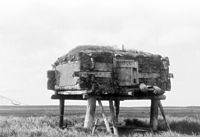
Photo from wikipedia
The aim of this study was to determine the effect of sealing methods, grain volume and lighting candle in metal silo for the control of Prostephanus truncatus in stored maize.… Click to show full abstract
The aim of this study was to determine the effect of sealing methods, grain volume and lighting candle in metal silo for the control of Prostephanus truncatus in stored maize. Metal silos with 100 kilograms holding capacity were loaded with 90 kilograms of grain, in-let and out-let were covered with lids and sealed either with rubber band, grease, rubber band combined with grease and lid without sealing (control). The control suffered highest grain damage of 6.6% and weight loss of 1.9% compared to metal silo sealed using rubber band combined with grease which had grain damage 4.5% and weight loss 0.6%, thirty-five days after storage. Metal silo sealed with rubber band combined with grease had significantly higher CO2 level of 2.1% v/v than the control 0.5% v/v. In a separate experiment, metal silos with: 90 kilograms of grain, with and without lighted candle; 45 kilograms of grain, with and without lighted candle and a polypropylene bag with 90 kilograms of grain were compared. Ninety days after storage, grain stored in all metal silos regardless of grain volume and candle lighting suffered the least weight loss 0.2% to 1.1%, and damage 4.1% to 10.5% compared to grain in polypropylene bags which had the highest loss 7.3% to 25.3% and damage, 28.9% to 37.5%. All metal silos irrespective of grain volume and candle lighting during storage had 100% insect mortality while in control the number of live P. truncatus increased from 100 to 1786, ninety days after storage. Proper sealing of metal silo with either rubber band or grease and use of lighted candle effectively controlled P. truncatus in stored maize irrespective of grain volume.
Journal Title: Journal of Agricultural Science
Year Published: 2018
Link to full text (if available)
Share on Social Media: Sign Up to like & get
recommendations!